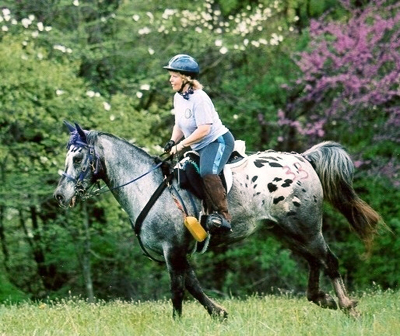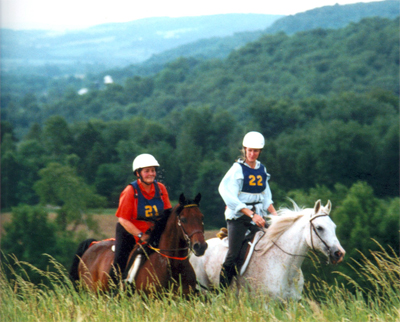Competitive Trail Riding: What You Need to Know
Distance rider and writer Patti Brooks shares expert advice and information on Competitive Trail Riding, including must-have gear and horses that can go the distance.
by Patti Brooks
I know you! You’re always looking for new adventures with your horse. Nothing is quite so perfect for you than spending a sunny day in the saddle exploring new trails. But you like challenges, too, and you’re pretty sure there is more to life than the military precision of competing in the show ring. Have you tried Competitive Trail Riding (CTR)? From Maine to Virginia there is an organization that sanctions rides from 12 mile Conditioning Distance Rides all the way to 3-day 100 Mile Rides. Entering rides sanctioned by the Eastern Competitive Trail Ride Association (ECTRA) will ensure you of well marked trails and experienced veterinarian and lay judges.
I interviewed a dozen-plus trail riders who are members of ECTRA. Their combined statistics add up to 320 years of distance riding completing 149,000 miles of competition! I pulled some kernels of wisdom from all this expertise.

Brenda Senseney - local photographer
Best Horse Breeds
Arabians dominate the sport mostly because of their great ability to pulse down quickly (return to required end-of-ride pulse and respiration in 20 minutes) Generally speaking, heavily muscled horses take more conditioning to achieve the same results.
Lee Alexander (VT), a trail rider of 40 years has successfully competed with mules, a Belgium-Arabian cross and is currently competing a Morgan who is “honest and loves his job.”
When asked what was their all time favorite horse, I noted what I believe is the sign of a true horseman. Steve Rojek (VT), said his favorite horse is “...the one I’m riding at any given time.” You can bet the horse picks up on that feeling and gives his best to the rider that thinks he’s great.
Ester Fiddes (CT), a 20 yr member of ECTRA said “Each horse has been splendid and wonderful in their own way.” Cate Peloquin (MD), admits that an Appaloosa is her favorite horse but quickly adds, “...but I do not tell any of my horses that. I tell them each they are my favorite.”
Most riders interviewed feel the most important traits to take into account when deciding if your horse is a distance candidate is soundness with good feet and bones. A durable horse that can go the distance. Other riders feel a great prospect is one that loves the trail and his job and is ready to move out. Wanda Stazick (CT), loved the hours spent with her Morgan, saying, “...he is a horse with grit and determination...always wanted to be in front of the pack...never would not move out.”

Molly and Libby Koher crossing water on 25 mile ride. Phtographer Jan Lynick.
Competitive Trail Riding Lingo: Pulse and Respiration
Years on the trail has taught most riders that the best horse listens to his rider, and is at ease on the trail with a sound mind. Char Jewell (ME) says a good CTR horse “...has to like his job. That includes being manageable...more brains than guts.” A well trained horse that hasn’t been arguing with his rider will have the best chance to meet the final Pulse and Respiration (P/R) of 44/24.
Don’t think for a minute the entire ride revolves around P/Rs. It’s simply that many horses have gone through their conditioning so well, that tack and shoeing issues have been resolved before the day of the ride. P/Rs are a black-and-white tool that often separates the men from the boys.

The detailed process of vetting a horse in before the start of a ride at the Green Mountain Horse Association facility in Vermont. Photographer Patti Brooks.
What to Wear & Bring Along for the Ride
And, speaking of resolving issues before ride day. Do NOT wear, or put on you horse, anything new. If the article hasn’t been used at home for hours/miles, you take a big chance of it causing a painful issue during the competition. And, yes...that even applies for new underwear!
Riding tights appear to be the hands-down favorite among trail riders, with a few opting for breeches. Many use half-chaps, but basically, as Lee Alexander (VT) says, “whatever works.” There is no official dress code for rider or horse.
Without a doubt, Mary Coleman (PA) says the most important thing to bring to a ride is “A sense of humor as things can and do go wrong!” Mary should be making the milestone of 14,000 miles this year with over half that on one tough Morgan gelding. Other riders were consistent in identifying sponges as the Must-Have article on a ride. A spare EZ boot was a close second.
Deb Fisk (VT) never leaves home without a “Breastplate, regardless of how the saddle fits.” I agree with Deb and I add a crupper. I want my saddle to stay where I’ve judged best no matter how steep the mountain I’m climbing or descending. And, as I tire and perhaps get sloppy in the saddle, a breastplate and crupper does much to save my horse’s back and his way of traveling.
When Jim Theurer (PA) sets up at a multi-day ride (or arrives the night before a one-day), he loves his portable pen of “...four 10' panels that make a temporary stall. I don’t worry about my horse at night and can rest comfortably.” Jim competes with an Arabian/Paint and a Clydesdale/Paint.
You won’t have to worry about mystical, secret potions for your horse as none are allowed. Stick to electrolytes, fly repellent and approved joint lubricants and you’re good to go. Add lots of water for drinking and sponging to both clean and cool. (water may not be heated or cooled)
Most riders prefer to keep their horses out at least half a day. Char Jewell (ME) wants to make sure her horses are comfortable being stabled as some rides require horses to be stabled and “...so they get enough sleep. It is proven that some horses do not well in herd situations...lack of sleep can have detrimental effects.” Many keep horses out 24/7 with shelters.

Riders in the New York 100 Mile Ride. Photographer Carien Schippers.
Conditioning & Preparation
These riders with thousands of miles under their belts pretty uniformly ride three to five times a week depending upon job and family demands. The average is +/-5 miles with a 10+ mile ride once a week. If headed for a 25 mile ride, for instance, most like to work up to several 15 mile rides before hand.
Char Jewell (ME), who has been at this sport for 27 years, wrote: “The most miles I do at one time is 13.5 - I usually stick with 5 - 7 miles a couple times a week.
On a 25 mile ride, you have 4:10 to 4:40 hours to complete the ride You will lose points if you come in too early or late.
There’s lots more about this sport. Start with www.ECTRA.org You’ll find the rules, monthly newsletter, a schedule of rides and lots of good stuff including how to become part of the ECTRA listserv where so many riders check in regularly with questions and, more importantly, solid answers.
Jeff Gardener (RI) expressed how he valued the years spent riding with his daughter, Katherine. “The horsemanship required to compete in CTR over a period of time has taught us significantly more about the care of our horses and our riding abilities than we would ever have learned otherwise. This CTR foundation has provided Katherine the horsemanship skills to move on to FEI international endurance riding. Even with FEI riding she is always excited to come back to her roots of ECTRA and CTRs.”
Will we see you on the trail next year?
About the Author: Patti Brooks, author of Horse-Powered Mysteries For the Read of Your Life. www.PattiBrooksBooks.com




